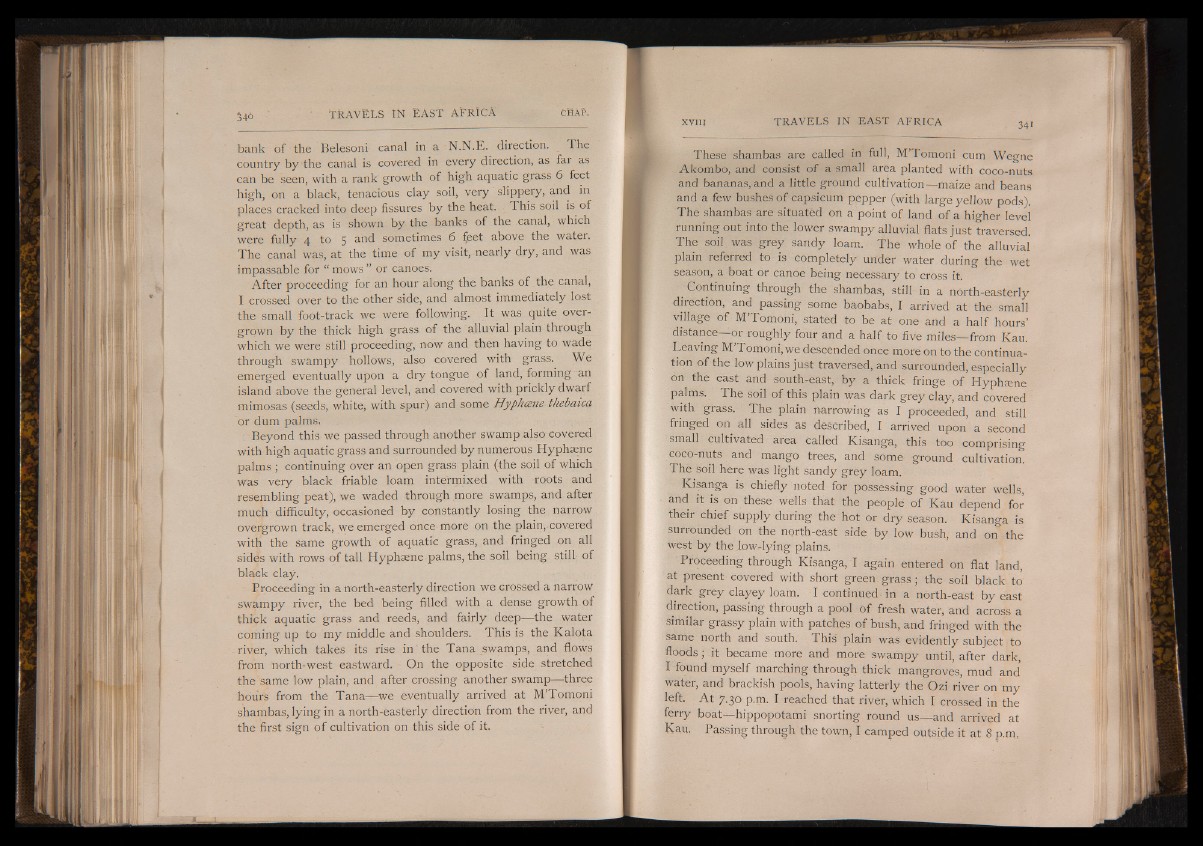
$4i>
bank of the Belesoni canal in a N.N.E. direction. The
country by the canal is covered in every direction, as far as
can be seen, with a rank growth of high aquatic grass 6 feet
high, on a black, tenacious clay soil, very slippery, and in
places cracked into deep fissures by the heat. This soil is of
great depth, as is shown by the banks of the canal, which
were fully 4 to 5 and sometimes 6 fpet above the water.
The canal was, at the time of my visit, nearly dry, and was
impassable for “ mows ” or canoes.
After proceeding for an hour along the banks of the canal,
I crossed over to the other side, and almost immediately lost
the small foot-track we were following. It was quite overgrown
by the thick high grass of the alluvial plain through
which we were still proceeding, now and then having to wade
through swampy hollows, also covered with grass. We
emerged eventually upon a dry tongue of land, forming an
island above the general level, and covered with prickly dwarf
mimosas (seeds, white, with spur) and some Hyphcene thebaica
or dum palms.
Beyond this we passed through another swamp also covered
with high aquatic grass and surrounded by numerous Hyphsene
palms ; continuing over an open grass plain (the soil of which
was very black friable loam intermixed with roots and
resembling peat), we waded through more swamps, and after
much difficulty, occasioned by constantly losing the narrow
overgrown track, we emerged once more on the plain, covered
with the same growth of aquatic grass, and fringed on all
sides with rows of tall Hyphsene palms, the soil being still of
black clay.
Proceeding in a north-easterly direction we crossed a narrow
swampy river, the bed being filled with a dense growth of
thick aquatic grass and reeds, and fairly deep— the water
coming up to my middle and shoulders. This is the Kalota
river, which takes its rise in the Tana swamps, and flows
from north-west eastward. On the opposite side stretched
the same low plain, and after crossing another swamp— three
hours from the Tana— we eventually arrived at M’Tomoni
shambas, lying in a north-easterly direction from the river, and
the first sign of cultivation on this side of it.
These shambas are called in full, M’Tomoni cum Wegne
Akombo, and consist of a small area planted with coco-nuts
and bananas, and a little ground cultivation—maize and beans
and a few bushes of capsicum pepper (with large yellow pods).
The shambas are situated on a point of land of a higher level
running out into the lower swampy alluvial flats just traversed.
The soil was grey sandy loam. The whole of the alluvial
plain referred to is completely under water during the wet
season, a boat or canoe being necessary to cross it.
Continuing through the shambas, still-in a north-easterly
direction, and passing some baobabs, I arrived at the small
village of M’Tomoni, stated to be at one and a half hours’
distance— or roughly four and a half to five miles— from Kau.
Leaving M’Tomoni, we descended once more on to the continuation
of the low plains just traversed, and surrounded, especially
on the east and south-east, by a thick fringe of Hyphaene
palms. The soil of this plain was dark grey clay, and covered
with grass. The plain narrowing as I proceeded, and still
fringed on all sides as described, I arrived upon a second
small cultivated area called Kisanga, this too comprising
coco-nuts and mango trees, and some ground cultivation.
The soil here was light sandy grey loam.
Kisanga is chiefly noted for possessing good water wells,
and it is on these wells that the people of Kau depend for
their chief supply during the hot or dry season. Kisanga is
surrounded on the nprth-east side by low bush, and on the
west by the low-lying plains.
Proceeding through Kisanga, I again entered on flat land,
at present covered with short green, grass; the soil black to
dark grey clayey loam. I continued in a north-east by east
direction, passing through a pool of fresh water, and across a
similar grassy plain with patches of bush, and fringed with the
same north and south. This' plain was evidently subject to
floods; it became more and more swampy until, after dark,
I found myself marching through thick mangroves, mud and
water, and brackish pools, having latterly the Ozi river on my
left. A t 7’30 P-fii- I reached that river, which I crossed in the
ferry boat—hippopotami snorting round us— and arrived at
Kau. Passing through the town, I camped outside it at 8 p.m,